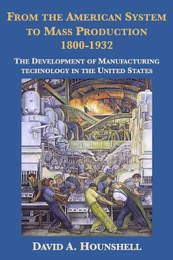 $9.99 on Kindle, Nook, Apple Books, Kobo, Google Play
$9.99 on Kindle, Nook, Apple Books, Kobo, Google PlayFrom the American System to Mass Production 1800-1932: The Development of Manufacturing Technology in the United States by David Hounshell (188,000 words, 162 illustrations)
“In From the American System to Mass Production, David A. Hounshell has provided a detailed, thoughtful, and comprehensive examination of American industrial technology from the early 1800s through the 1930s. Lavishly illustrated with 19th-century prints and more recent photographs of factory interiors and industrial products, this important work traces the direct and indirect routes down the road toward modern American industrial civilization. For business and labor historians and for historians of American technology and industrialization, Hounshell’s book will fill many gaps in the history of the technical contours of modern industrial America... [the book] begins with an examination of the origins of the American system of manufactures in government and private arms production and then moves to the sewing machine, woodworking, agricultural equipment, bicycle, and automobile industries. It touches on the important inventors and innovators and describes their fundamental contributions in these American industries. Most of the principal figures and institutions are covered: Simeon North, Eli Whitney, Thomas Blanchard, John H. Hall, and Samuel Colt in armories, Eli Terry and Seth Thomas in the clockmaking industry, the Wheeler and Wilson, Willcox and Gibbs, and Singer sewing machine firms, the Singer woodworking plant, the McCormick Reaper works, the Columbia, Pope, and Western Wheel Works bicycle companies, and the Ford and General Motors automotive corporations... Hounshell’s work is a major contribution to the social history of technical innovators and their innovations... All in all, From the American System to Mass Production is an impressive work. In his documentation of the history of American industrial technology, Hounshell has demonstrated the slow evolution and the near-failure of large-scale, capital-intensive, and work-degrading industrial systems. Whereas other historians of technology have tended to tread too lightly on the social dimensions of technical change, Hounshell has provided an excellent social analysis of the networks of innovators and their role in the diffusion of armory practices and other industrial advances from industry to industry.” — Stephen Meyer, Technology and Culture
“Mr. Hounshell is an enthusiastic, lively writer, yet very careful scholar. He is cautious in his conclusions and candid about what is debatable. He offers several sides of every issue; he does not judge particular technologies as good or bad... What stands out in this history is how slowly what appears to be a sensible, productive and efficient system of manufacturing was adopted, chiefly because it required a change in the mind-set of managers, changes in skills and work habits of workers, and disciplined procedures and practices throughout the plants.” — Wickham Skinner, New York Times Book Review
“David Hounshell’s history of the evolution of American production methods has few rivals; in execution of the theme, it has none... Hounshell carefully documents the development, transfer, and modification of the technology of the manufacture of interchangeable parts from firm to firm and industry to industry... A series of excellent technical photographs and Hounshell’s own field trials support his argument.” — Jeremy Atack, Science
“From the American System to Mass Production, 1800-1932... is a meticulous study of mass production’s roots and early flowering... An able researcher, [Hounshell] follows the trail of early manufacturing ideas and shows how they were gradually perfected and diffused throughout different industries before converging in Ford’s miracle at Highland Park.” — Melvin D. Barger, Wall Street Journal
“[An] important study which offers a convincing reinterpretation of the development of mass production in the United States. [Hounshell] has combined substantial new archival research with a synthesis of the mass of new work completed by others in the past three decades. The book is clearly written and has nearly one hundred and fifty well-chosen illustrations which help the reader understand the products and processes described in the text.” — Charles K. Hyde, Journal of Economic History
“This is an example of the history of technology at its very best. It is also a volume which has a great deal to interest the business historian.” — David J. Jeremy, Business History
“From the American System to Mass Production is about the diffusion and assimilation of new technologies among large-scale manufacturers. Specifically, it focuses on how innovations that originated in the antebellum small arms industry spread to other technically related industries during the nineteenth century and, with further elaborations and additions, eventually culminated with Henry Ford’s system of mass production in 1913. In detailing how various innovations filtered from firm to firm and industry to industry, Hounshell breaks new ground. Historians have long realized that a genealogical connection existed between arms making and other metalworking industries in the United States. But they knew relatively little about how it actually took place. Hounshell now makes these connections clear for clock, sewing machine, furniture, reaper, bicycle, and automobile manufacturing, and he does so in exquisite detail. What is more, he reveals how inherently complicated the process of change and adaptation really was. No proforma rendition of unilinear progress here. Instead of relating heroic feats of genius, Hounshell chronicles the aggravating, frustrating, and mundane aspects of innovation.” — Merritt Roe Smith, Reviews in American History
“David A. Hounshell’s objective in this important book is wonderfully simple. He aims to set the record straight about the historical development of American manufacturing technology. The research is impressive, but he has organized it in such a straightforward fashion that his argument becomes powerfully persuasive. One of the virtues of this workmanlike vision of historical scholarship is that a central theme in American technology has been made accessible to the generality of American historians.” — Bruce Sinclair, The Journal of American History
“[Hounshell] not only charts new directions for the study of technology but also comes close to bridging the wide gap between business history and the history of technology. Moreover, his book addresses problems of importance in today’s economy without sacrificing quality history. It informs us without teaching and converts without preaching. Hounshell’s achievement is nothing less than a feat of history conjury: his book brings machines to life.” — Mary A. Yeager, American Historical Review
“David Hounshell’s book is a monumental contribution. Never before has anyone systematically explored the technical aspects of mass production — the machines, the work layouts, the division of labor — over time and in a variety of crucial industries, by way of tracing the technology from its first application in military armories... through sewing machines, wooden furniture, agricultural machinery, and the bicycle, to its triumph in large-scale consumer manufacture with Henry Ford’s assembly line. And never before has the reader been offered such an array of well-chosen and well-described iconographic material... [T]he book is a pleasure to read.” — David S. Landes, Isis
“One of the most important contributions of Hounshell’s book is that it takes this intervening period [1850-1900] into account, and not just superficially. The analyses of sewing machine, reaper, and bicycle manufacture are based on extensive archival and primary research... The result is a more comprehensive, integrated, and meaningful portrayal of the rise of mass production in these industries than we have had previously.” — Eda Kranakis, International Labor and Working-Class History
“David Hounshell... offers a convincing reinterpretation of mass production’s 19th century roots and its eventual culmination in the cul-de-sac of Fordism. His story is an evolutionary one but not one of unilinear progress; instead, it is a bumpy path of fits and starts, a slow, frustrating process in which developments are unevenly distributed cross firms and industries. The volume is engagingly written and replete with more than 150 wonderful illustrations.” — Walter W. Powell, American Journal of Sociology
“[T]his work should be essential reading for any who are interested in the technology of nineteenth or twentieth century work-places.” — Edward W. Constant II, Journal of Social History
“For those with an academic, professional or personal interest in manufacturing or American social history, the book is a gold mine.” — James V. Higgins, The Detroit News



